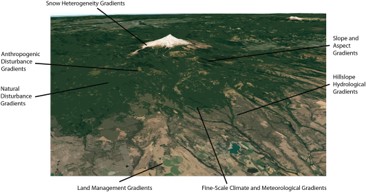The Science
The land surface is a crucial part of the Earth system, and land surface models (LSMs) are key to some of the most important problems facing society today. But large uncertainty in LSM predictions, and a poor ability to attribute the sources of that uncertainty, mean that new strategies are needed. We identify three “grand challenges” facing LSM developers and propose strategies to help overcome these problems.
The Impact
This article, part of an invited collection of Grand Challenges papers published in AGU journals, seeks to focus LSM developers on the largest problems facing land surface science. We seek to galvanize the community to focus on problems related to process complexity, the many dimensions of sub-gridscale heterogeneity, and the representation of coupled physical-ecological dynamics, as key barriers in LSM science.
Summary
LSMs are critical pieces of Earth system models, needed for projection of the extent of global change, as well as impacts on critical terrestrial systems such as agriculture, freshwater resources, ecosystems, and built infrastructure. However, LSM predictions show a stubborn uncertainty that has been difficult to attribute to specific process representations and parameter values. At the same time, the scope of LSMs has grown complex—for valid reasons—because of the many interacting processes that make up terrestrial systems. We argue that, as a first “Grand Challenge”, the LSM community must focus more clearly on the process complexity of LSMs, in order to better allow scaling from simplified models to highly interacting representation of a full LSM. A second “Grand Challenge” relates to the differing views of heterogeneity in LSMs, which focus on various subsets and combinations of, e.g., disturbance, hillslopes, microclimate, vegetation communities, recent weather, snow depth, land management, and others. But a general approach to identifying what are the dominant dimensions of heterogeneity at a given location, and how to most efficiently resolve that heterogeneity has not yet emerged. A third “Grand Challenge” is on how to understand the dynamics of model parameters that are governed by complex interactions between physical and ecological dynamics; in particular we review three leading approaches: empirical, optimality-based, and competition-resolving, and identify questions about when to use each of these, how different aspects may and may not be combined, and what the implications are for each of these.

Contacts (BER PM): Renu Joseph and Dan Stover, Renu.Joseph@science.doe.gov (301-903-9237), and Daniel.Stover@science.doe.gov (301-903-0289)
PI Contact: Charlie Koven, Staff Scientist, Lawrence Berkeley National Lab, cdkoven@lbl.gov, 510.486.6724
Funding
DOE Early Career Research Program, Rubisco SFA, NGEE-Tropics
Publications
Fisher, R. A., and Koven, C. D. (2020), Perspectives on the Future of Land Surface Models and the Challenges of Representing Complex Terrestrial Systems, Journal of Advances in Modeling Earth Systems, doi:10.1029/2018MS001453